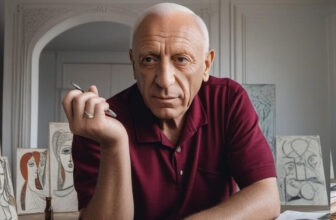
The Mystery and Legacy of Leonardo da Vinci’s Grave
Leonardo da Vinci, one of history’s most celebrated polymaths, left an indelible mark on the worlds of art, science, and engineering. While much is known about his life and groundbreaking achievements, the story of his grave and final resting place adds another layer of intrigue to his enduring legacy. This article delves deep into the history, mystery, and reverence surrounding Leonardo’s burial site.
Leonardo’s Final Days
In the twilight of his life, Leonardo da Vinci found solace and patronage in France. Invited by King Francis I, he resided at the Château du Clos Lucé in Amboise. Here, Leonardo spent his final years working on various projects, engaging in intellectual discussions, and contemplating his life’s work. Despite being in his mid-sixties, an advanced age for the Renaissance period, Leonardo’s mind remained as vibrant as ever.
Leonardo passed away on May 2, 1519, at the age of 67. Historical accounts suggest that Francis I held the artist in such high regard that he may have been present at Leonardo’s deathbed, cradling the great mind as he took his final breaths. Whether this story is true or a romanticized legend, it underscores the profound respect Leonardo commanded.
The Original Burial Site
After his death, Leonardo da Vinci was interred in the chapel of Saint-Florentin at the royal Château d’Amboise. This chapel, part of a larger castle complex overlooking the Loire River, was a fitting location for a man of Leonardo’s stature. His burial was modest, yet dignified, in keeping with the Renaissance traditions of the time.
Unfortunately, the chapel of Saint-Florentin did not stand the test of time. During the French Revolution and subsequent years, the château suffered significant damage. The chapel was eventually demolished in the early 19th century, and its exact location faded from memory. This led to centuries of uncertainty about the fate of Leonardo’s remains.
Rediscovery and Relocation
In 1863, a group of archaeologists uncovered a grave at the presumed site of the Saint-Florentin chapel. Among the remains, they found a stone inscribed with the letters “EO ARDUS VINC,” believed to be a partial rendering of Leonardo’s name. These findings led many to conclude that the grave was indeed Leonardo’s.
Following the discovery, the remains were relocated to the Chapel of Saint-Hubert, also at the Château d’Amboise. This smaller, Gothic-style chapel, nestled within the castle grounds, became the new resting place for the presumed remains of Leonardo da Vinci. Today, visitors can find a tomb marked with his name, surrounded by an air of reverence and curiosity.
The Debate Over Authenticity
Despite the relocation, the authenticity of the remains attributed to Leonardo da Vinci remains a subject of debate among historians and archaeologists. The chaos of the French Revolution, coupled with the chapel’s destruction, makes it difficult to verify with absolute certainty that the bones interred in Saint-Hubert are indeed Leonardo’s. DNA testing has been proposed as a means to resolve the mystery, but obtaining a reliable sample for comparison has proven challenging.
Several descendants of Leonardo’s family, traced through his father’s lineage, have been identified. This opens the possibility of conducting genetic analysis to confirm the identity of the remains. However, ethical considerations and the sanctity of the burial site complicate such efforts.
Visiting Leonardo’s Tomb
For those captivated by Leonardo da Vinci’s genius, a visit to the Château d’Amboise is a pilgrimage of sorts. The Chapel of Saint-Hubert, with its intricate carvings and serene ambiance, offers a tranquil space to reflect on Leonardo’s contributions to humanity. The tomb, simple yet profound, serves as a reminder of the ephemeral nature of life and the enduring power of ideas.
Visitors to the château can also explore the nearby Château du Clos Lucé, where Leonardo spent his final years. This residence has been transformed into a museum, showcasing replicas of Leonardo’s inventions, manuscripts, and artworks. Together, these sites provide a comprehensive look at the final chapter of Leonardo’s life.
The Legacy of Leonardo da Vinci
Leonardo da Vinci’s grave is more than just a resting place; it’s a symbol of his timeless legacy. His insatiable curiosity, boundless creativity, and unwavering pursuit of knowledge continue to inspire generations. From the Mona Lisa and The Last Supper to his anatomical studies and visionary designs, Leonardo’s body of work transcends the boundaries of time and discipline.
The mystery surrounding his grave adds another layer of fascination to his story. It serves as a metaphor for the enigmatic nature of his genius, always inviting exploration, never fully understood.
The story of Leonardo da Vinci’s grave is a testament to the enduring impact of his life and work. While questions about the authenticity of his remains linger, the reverence for his contributions remains unwavering. Whether you’re an art enthusiast, a history buff, or simply a curious traveler, the tale of Leonardo’s final resting place offers a compelling journey into the life of a true Renaissance icon. As we continue to celebrate his achievements, the mystery of his grave reminds us that even in death, Leonardo da Vinci remains a source of wonder and inspiration.





